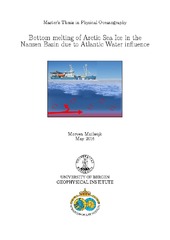Bottom melting of Arctic Sea Ice in the Nansen Basin due to Atlantic Water influence
| dc.contributor.author | Muilwijk, Morven Korneel | |
| dc.date.accessioned | 2016-08-22T07:38:38Z | |
| dc.date.available | 2016-08-22T07:38:38Z | |
| dc.date.issued | 2016-05-24 | |
| dc.date.submitted | 2016-05-24 | eng |
| dc.identifier.uri | https://hdl.handle.net/1956/12661 | |
| dc.description.abstract | The hydrographic situation for a region north of Svalbard is investigated using observations from the Norwegian Young Sea Ice Cruise (N-ICE2015). Observations from January to June 2015 are compared to historical observations with a particular focus on the warm and salty Atlantic Water (AW) entering the Arctic Ocean through the Fram Strait. Here we discuss how the AW has changed over time, what governs its characteristics, and how it might influence the sea ice cover. We find that AW characteristics north of Svalbard are mainly controlled by the distance along the inflow path, and by changes in inflowing AW temperature in the Fram Strait. AW characteristics north of Svalbard are also largely affected by local processes such as sea ice growth, melting and tidal induced mixing. Furthermore, one dimensional model results and observations show that AW has a direct impact on the sea ice cover north of Svalbard. Shallow and warm AW efficiently reduces sea ice growth and results in bottom melting throughout the whole year. The historical observations and outcome from a fully coupled earth system model show a warming trend of AW core temperature over the last few decades. We believe that the AW warming trend in the Arctic Ocean may be part of long term multi-decadal variability, which is influenced by anthropogenic forcing. Simulations suggest that approximately 30 % of the recent warming may be attributed to global warming. | en_US |
| dc.format.extent | 13773691 bytes | eng |
| dc.format.mimetype | application/pdf | eng |
| dc.language.iso | eng | eng |
| dc.publisher | The University of Bergen | en_US |
| dc.subject | Atlantic water | eng |
| dc.subject | Oceanography | eng |
| dc.subject | Nansen Basin | eng |
| dc.subject | Arctic Sea Ice | eng |
| dc.subject | Lance | eng |
| dc.subject | Global warming | eng |
| dc.subject | Climate change | eng |
| dc.subject | Svalbard | eng |
| dc.subject | Hydrography | eng |
| dc.subject | ADCP | eng |
| dc.subject | CTD | eng |
| dc.subject | Mixed Layer | eng |
| dc.subject | N-ICE2015 | eng |
| dc.subject | Fram | eng |
| dc.subject | Bottom Melting | eng |
| dc.subject | PHC | eng |
| dc.subject | World Ocean Atlas | eng |
| dc.subject | AOTIM | eng |
| dc.subject | Circulation | eng |
| dc.subject | NorESM | eng |
| dc.subject | Model Ocean | eng |
| dc.subject | Nautilus | eng |
| dc.subject | Tides | eng |
| dc.subject | TEOS-10 | eng |
| dc.subject | Freshwater | eng |
| dc.title | Bottom melting of Arctic Sea Ice in the Nansen Basin due to Atlantic Water influence | en_US |
| dc.type | Master thesis | |
| dc.rights.holder | Copyright the Author. All rights reserved | en_US |
| dc.description.degree | Master i Meteorologi og oseanografi | en_US |
| dc.description.localcode | MAMN-GEOF | |
| dc.description.localcode | GEOF399 | |
| dc.subject.nus | 756213 | eng |
| fs.subjectcode | GEOF399 |
Tilhørende fil(er)
Denne innførselen finnes i følgende samling(er)
-
Geophysical Institute [1198]
